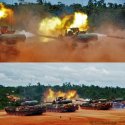You are using an out of date browser. It may not display this or other websites correctly.
You should upgrade or use an alternative browser.
You should upgrade or use an alternative browser.
Modern Main Battle Tanks ( MBT )
- Thread starter FORBIN
- Start date
For Scratch, planned for this year German Army recovers 100 Léopard 2 in stock, from 230 to 330 good but thinking only in addition to the Fleet, no new units ?


Get Ready, Russia: This European Power Has Plans For a Lethal New Tank
Faced with the resurgent threat of Russian armor, Germany has embarked on a program to develop a next-generation main battle tank that has sometimes been called the Leopard 3. The long overdue move comes after Berlin neglected the Bundeswehr for over two decades following the end of the Cold War and reunification of Germany.
In the short- to medium-term, Germany will have to rely on upgrading the already formidable to counter Russia’s next-generation main battle tank. Longer term, Germany recognizes that it will have to replace the Leopard 2 with a new design in years 2030 and beyond. As such Berlin has embarked on developing the next-generation Main Ground Combat System (MGCS) in conjunction with France.
According to a November 2015 presentation by Armin Papperger, chief executive officer of, which builds key components of the Leopard 2 and the American M1A2 Abrams, the journey toward MGCS will be an incremental evolution. The first step will be to upgrade the Leopard 2 with a new digital turret core system, new situational awareness system and an Active Defense System (ADS).
The tank will also need a new high-pressure 120mm cannon and new ammunition. Papperger expects that the new gun and ammunition will yield twenty percent better performance than the current L55 120mm cannon. However, it’s not clear how much further the weapon can be extended. There are significant drawbacks to a longer cannon—which is one of the reasons the U.S. Army retains the shorter L44 120mm cannon for its Abrams. It’s possible that Rheinmetall is using new materials to increase the pressure within the cannon without increasing the cannon’s length.
In the medium term, Germany will have to refit the Leopard 2 with a new 130mm cannon, Papperger said. The 130mm gun is a new concept—earlier NATO studies had looked at refitting the Leopard 2 and Abrams with a much larger 140mm cannon to counter late-Cold War Soviet developments. Nonetheless, the 130mm gun would offer fifty percent better armor penetration performance than a 120mm cannon. Rheinmetall will kick-off the work on the new gun—which is one of the preconditions for developing the MGCS—later this year.
Papperger said that work on the MGCS concept development has already started. The new main battle tank is in a concept development phase between the German and French governments and industry. While France is the only current partner, the Germans expect other European nations to jump onboard the project. The concept development phase should be completed by 2017.
The new MGCS’s focus on increased firepower is directly being driven by Russia’s Armata program—which many defense officials regard as being particularly problematic. Simply put, the Armata series armored vehicles—particularly with their focus on active protection systems (APS)—are forcing Western designer to focus more direct fire weapons.
The Armata’s Afghanit APS is believed to incorporate at least one type of hard-kill countermeasure designed to intercept incoming projectiles—according to the International Institute for Strategic Studies’s (IISS) Military Balance 2016. The IISS assessment is also backed up by Russian sources, which suggests that the Armata launches interceptor rounds fitted with explosively formed penetrators—which might be effective even against incoming kinetic energy projectiles. However, APS systems are always most effective when used against chemical energy rounds like rocket-propelled grenades or missiles.
“Most revolutionary is the Armata-based T-14 Main Battle Tank featuring an uncrewed turret. There is emphasis on protection across the platforms—including active protection systems (APS)—reflecting lessons learnt as well as perceptions of future operating environments,” states the The report adds:
“When it enters service Armata will be the first tank designed for an unmanned turret and APS. Successful fielding of APS will reduce the effectiveness of anti-tank guided missiles and shoulder-fired weapons such as rocket propelled grenades. This will change battlefield dynamics by increasing the importance of cannon, anti-tank guns and tanks.”
While Germany has traditionally been a leader in armored warfare, Berlin has neglected the Bundeswehr in recent years. Only time will tell if Germany is successful in its plans.


plawolf
Lieutenant General
Jezz, the guys at national interest must feel nostalgic or something. The title of that article title sounds like it came right out of a WWII/Cold War propaganda poster.
Anyways, but 2030, I would expect rail guns on tanks to be honest.
I think that is the next big thing for tank design, alongside active protection and proto-shield technology.
All of those advancements would necessitate a quantum leap in energy generation and/or storage technology, but I think from a feasibility point view, the time frame seems like it should be possible, and I would expect energy weapons to debut on land systems (after naval) before the technology is mature and refined enough to consider aerospace applications.
Anyways, but 2030, I would expect rail guns on tanks to be honest.
I think that is the next big thing for tank design, alongside active protection and proto-shield technology.
All of those advancements would necessitate a quantum leap in energy generation and/or storage technology, but I think from a feasibility point view, the time frame seems like it should be possible, and I would expect energy weapons to debut on land systems (after naval) before the technology is mature and refined enough to consider aerospace applications.











